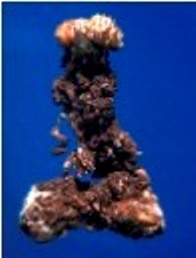The missing piece W
Welcome to the intriguing world of Cordyceps subsessilis
Cordyceps subsessilis has not always been known to be a big part of Cyclosporine history. As a matter of fact, it was not known at all to be a part of it until about 17 years ago.
In the year of 1994, Kathie Hodge and a group of students in a field mycology class went looking for fungus in the upper part of New York. They were expecting to find some interesting specimens, but none to the point of what they brought back. Throughout the trip sometime, some one picked up Cordyceps subsessilis, and threw it in the collection, glad to have found such an interesting specimen. It was only later on that it was identified as something special.
When examining these specimens in the lab, the common fungi were able to be separated from the more unique fungi that could be examined and identified by the students. When it came up to identifying this particular guy, it didn't quite work out that way.
Hodge and her team determined that this guy was
Cordyceps subsessilis but upon germinating the spores that came from it,
she discovered that this fungi had a different and very
important asexual state called Tolypocladium inflatum. No, this doesn't
sound like anything important, except that Tolypocladium inflatum
single-handedly made organ transplants possible. Since 1984 we have known
that this fungus is what produces Cyclosporine, a drug that suppresses the
immune system so that tissues (transplants) do not get rejected.
anything important, except that Tolypocladium inflatum
single-handedly made organ transplants possible. Since 1984 we have known
that this fungus is what produces Cyclosporine, a drug that suppresses the
immune system so that tissues (transplants) do not get rejected.
Yes indeed, the fungus found in the woods by a field mycology class turned out to be the telomorph (sexually producing stage) and the producer of Cyclosporine.
Now the puzzle is complete, the known Tolypocladium inlfatum, known producer of Cyclosporine, has actually got a sexual state that can be found in the woods. Although it has only been spotted a few times, there is indeed a sexually producing state.
If you would like to learn more about Kathie Hodge and the discovery of Cordyceps subsessilis in upper New York, click here!
To continue learning about this fascinating fungus click here to go to the classification of Cordyceps subsessilis.
Multipleorganisms.net is a project done by students in the Biology 203 class at the University of Wisconsin La Crosse. Each semester, the students create web pages based off a theme of organisms. This semester it is medicinal organisms. To learn about more organisms that are a part of this project, click here!
To look at some other medicinal organisms, here are just a few that may catch your attention!
The willow tree: http://bioweb.uwlax.edu/bio203/2011/girard_stev/
Thebladderwack: http://bioweb.uwlax.edu/bio203/2011/harris_benj/
Medicinal leech: http://bioweb.uwlax.edu/bio203/2011/harris_mic2/
Streptomycin source: http://bioweb.uwlax.edu/bio203/2011/knight_jona/
Split gill mushroom: http://bioweb.uwlax.edu/bio203/2011/maki_lanc/
Salmonberry: http://bioweb.uwlax.edu/bio203/2011/ruiz_amel/
Peyote: http://bioweb.uwlax.edu/bio203/2011/toellner_kayl/
Enjoy exploring this web page and those linked to it!

